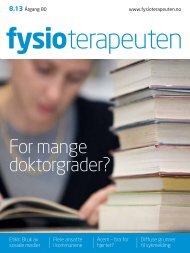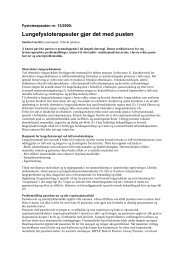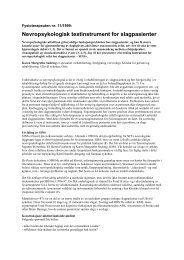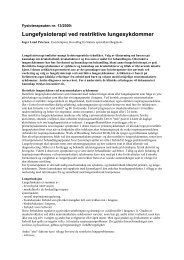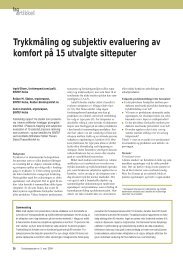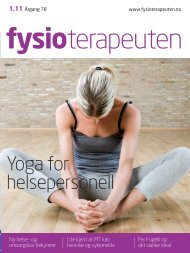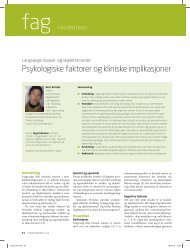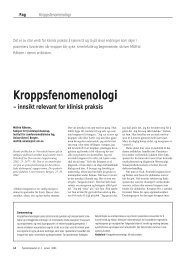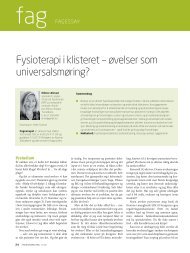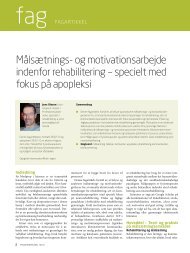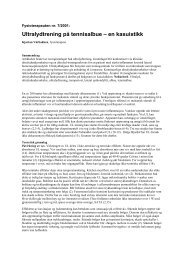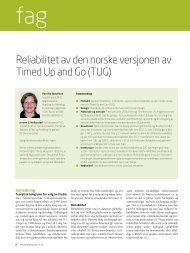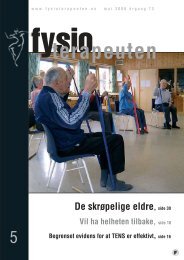Last ned PDF - Fysioterapeuten
Last ned PDF - Fysioterapeuten
Last ned PDF - Fysioterapeuten
You also want an ePaper? Increase the reach of your titles
YUMPU automatically turns print PDFs into web optimized ePapers that Google loves.
FAG BLIKK PÅ FORSKNING<br />
BLIKK PÅ FORSKNING<br />
Commentary<br />
Obesity and lack of physical activity are major risk factors for the<br />
development of Type 2 diabetes, and exercise (along with medication<br />
and diet) has long been recognised as one of the three cornerstones<br />
of diabetic therapy (Irvine and Taylor 2009). This very<br />
large randomized controlled trial provides further high quality<br />
evidence that high intensity and progressive exercise can benefit<br />
people with Type 2 diabetes.<br />
Although the reduction in HbA1c of 0.30% found in this trial<br />
may seem relatively small, any reduction in HbA1c is considered<br />
clinically significant as it is likely to reduce the risk of diabetic<br />
complications (Stratton et al 2000). We also need to consider that<br />
the baseline HbA1c values of the participants in this trial were<br />
considered to be only slightly elevated to start with; therefore a<br />
reduction of 0.30% in the exercise group allowed participants to<br />
achieve the recommended target HbA1c value of less than 7.0%<br />
(ADA 2008).<br />
The combi<strong>ned</strong> intervention was replicable and feasible as it<br />
was held in community-type gyms using readily available equipment<br />
(aerobic exercise consisted of either treadmill, step, ellip-<br />
26 FYSIOTERAPEUTEN 7/11<br />
Blikk på forskning utarbeides i samarbeid med Journal of Physiotherapy<br />
(Australia). Tidsskriftet trykker forskningspresentasjonene under betegnelsen<br />
Critically appraised Papers, CAPs.<br />
Supervised aerobic and resistance exercise improves glycaemic<br />
control and modifiable cardiovascular risk factors in people with<br />
Type 2 diabetes mellitus<br />
Synopsis<br />
Summary of: Balducci S et al (2010) Effect<br />
of an intensive exercise intervention strategy<br />
on modifiable cardiovascular risk factors in<br />
subject s with Type 2 diabetes mellitus. Arch<br />
Intern Med 170: 1794–1803. [Prepared by<br />
Nicholas Taylor, CAP Co-ordinator.]<br />
Question: Does an intensive exercise program<br />
improve glycaemic control, physical<br />
activity, and modifiable cardiovascular risk<br />
factors in patients with Type 2 diabetes mellitus?<br />
Design: Randomised, controlled trial<br />
with concealed allocation and blinded outcome<br />
assessment.<br />
Setting: 22 diabetic outpatient clinics in<br />
Italy.<br />
Participants: The trial included sedentary<br />
patients with Type 2 diabetes. Any conditions<br />
limiting or contraindicating physical<br />
activity were exclusion criteria. Randomisation<br />
of 606 participants allocated 303 to the<br />
intervention group and 303 to a comparison<br />
group.<br />
Interventions: Both groups received<br />
structured individual counselling every 3<br />
months over 12 months, which consisted<br />
of encouragement and strategies to achieve<br />
recommended levels of physical activity. In<br />
addition, the intervention group participated<br />
in an intensive exercise program. The 12<br />
month exercise program consisted of 150<br />
minutes per week in 2 sessions of progressive<br />
aerobic and resistance exercises supervised<br />
by an exercise specialist.<br />
Outcome measures: The primary outcome<br />
was the reduction in HbA1c (glycosylated<br />
haemoglobin) at 12 months. Secondary outcome<br />
measures were physical activity, and a<br />
range of cardiovascular risk factors including<br />
waist circumference, blood pressure, and<br />
coronary heart disease risk scores.<br />
Results: 563 participants (93%) completed<br />
the study. The median exercise training<br />
attendance was 80%. At 12 months, the reduction<br />
in HbA1c was significantly more in<br />
the exercise group by 0.30% (95% CI 0.10 to<br />
0.49). At 12 months, total physical activity<br />
improved significantly more in the exercise<br />
group than in the comparison group by 10<br />
MET-h/wk (95% CI 8.6 to 11.6). Waist circumference<br />
had decreased more in the exercise<br />
group than in the comparison group by<br />
3 cm (95% CI 2.9 to 4.4), systolic blood pressure<br />
had reduced more in the exercise group<br />
than the comparison group by 4.2 mm Hg<br />
(95% CI 1.6 to 6.9), and the coronary heart<br />
disease risk score had reduced more in<br />
the exercise group than in the comparison<br />
group by 3.1 units (95% CI 2.0 to 4.0).<br />
Conclusion: Exercise was effective in improving<br />
glycaemic control, increasing physical<br />
activity, and improving cardiovascular<br />
risk profile in sedentary people with Type<br />
2 diabetes mellitus, providing benefits over<br />
and above individual counselling.<br />
tical, arm or cycle ergometer, and resistance training consisted<br />
of chest press, lateral pull-down, squat/leg press, and abdominal<br />
exercises) over two sessions per week.<br />
The trial provides evidence that education alone is not adequate<br />
to cause sufficient behavioural change to reduce risk factors<br />
related to diabetes and cardiovascular disease. It is evident that<br />
adults also need a practical component to their learning in order<br />
to induce behavioural change that is adequate to obtain results.<br />
Exercise is a vital component of diabetes management and this<br />
trial is further evidence that structured, supervised exercise sessions<br />
get results.<br />
Casey Peiris<br />
La Trobe University and Eastern Health, Melbourne, Australia<br />
References<br />
American Diabetes Association (2008) Diabetes Care 31: s12–s54.<br />
Irvine C, Taylor N (2009) Aust J Physiother 55: 237–46.<br />
Stratton I et al (2000) BMJ 321: 405–12.<br />
Litteratur<br />
Peiris C. Appraisal critically appraised paper. J Physiother 2011; 57(2): 126.



